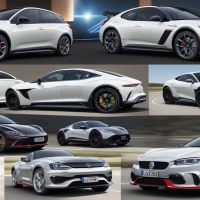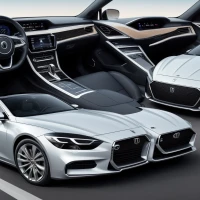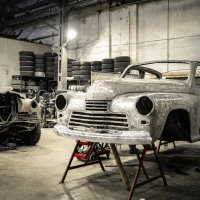When it comes to the heart of automotive engineering, few components are more critical than the cylinders within an engine. As the stronghold of a vehicle’s propulsion system, these cylindrical chambers are where the magic of motion begins. This article aims to demystify the mechanical marvel that is the car engine cylinder, providing an in-depth understanding of its functions, types, and impact on auto performance.
Whether you are an aspiring mechanic, a car enthusiast, or simply someone intrigued by the ingenuity of automobile engines, understanding the role of cylinders is fundamental. Let’s dive into the intricacies of cylinders in a car and discover all there is to know about this pivotal aspect of vehicle anatomy.
The Essence of Engine Cylinders
What Are Cylinders in a Car?
At its most basic, the cylinder in a car’s engine is a central component of the powertrain—a tube-shaped chamber where fuel combustion occurs. The number of cylinders can vary from engine to engine, typically ranging anywhere from one to twelve, each playing a pivotal role in influencing a vehicle’s performance, efficiency, and smoothness of operation.
How Do Cylinders Work in Conjunction with Other Engine Components?
Cylinders operate as part of a complex dance, working in harmony with the following elements:
- Pistons: Fit snugly within the cylinders to transfer the explosive force from combustion to mechanical energy.
- Crankshaft: Converts the linear motion of pistons into rotational force that ultimately turns the vehicle’s wheels.
- Valves: Control the intake of air and fuel as well as the exhaust of combustion gases.
- Spark Plugs (in gasoline engines): Ignite the air/fuel mixture, starting the combustion process.
- Fuel Injectors (in modern engines): Spray fuel into the cylinder in a fine mist to evenly mix with the air.
The Four-Stroke Combustion Cycle
The internal combustion engine cylinders typically operate on a four-stroke cycle:
- Intake Stroke: The intake valve opens, the piston moves down, and the cylinder fills with air and fuel.
- Compression Stroke: With the intake valve closed, the piston moves up, compressing the combustible mixture.
- Power Stroke: A spark ignites the mixture, creating a small explosion that forces the piston back down.
- Exhaust Stroke: The exhaust valve opens, and the piston moves up again to expel the combustion gases from the chamber.
Each of these strokes is essential for the efficient running of an engine, and any disruption in this cycle can lead to compromised vehicle performance.
The Influence of Cylinder Count on Vehicle Dynamics
Understanding the Variations in Cylinder Numbers
Vehicles are equipped with different numbers of cylinders based on the design and intent of the engine. Typically, you’ll encounter engines with:
- Four Cylinders: Known for their balance between power and efficiency, making them common in everyday vehicles.
- Six Cylinders (V6 or Straight-6): Offer a smoother ride and more power and are often found in more performance-oriented vehicles.
- Eight Cylinders (V8): Featured in cars requiring more torque and power, such as sports cars and trucks.
- Ten or Twelve Cylinders: Reserved for high-performance sports and luxury cars where maximum power is a necessity.
The Impact of Cylinder Configuration on Car Experience
The layout of cylinders also plays a significant role in a car’s performance:
- Inline or Straight Configuration: Cylinders arranged in a single row, typically leading to a simpler and more compact engine design.
- V Configuration: Cylinders aligned in two separate banks, forming a V shape, which allows for more cylinders in a compact space.
- Flat or Boxer Configuration: Cylinders positioned horizontally in two opposing rows, contributing to a lower center of gravity and improved vehicle handling.
Each configuration has distinct advantages and trade-offs, influencing factors such as engine size, weight distribution, and the overall balance of the vehicle.
Maximizing Performance: The Role of Cylinder Size and Displacement
Exploring Engine Displacement
Engine displacement refers to the total volume of all the cylinders within an engine, usually expressed in liters or cubic centimeters. It’s a measure of the engine’s size and its capacity to burn air-fuel mixture to produce power. Generally, a higher displacement indicates a more powerful engine, capable of generating greater torque and horsepower.
The Significance of Bore and Stroke
The dimensions of the cylinders—bore (diameter) and stroke (distance the piston travels)—affect engine characteristics:
- Bore: Larger bore sizes enable fitting larger valves, which facilitate better air and fuel flow.
- Stroke: A longer stroke increases torque but can limit the engine’s ability to rev high. Conversely, a shorter stroke typically means quicker revving capabilities but less torque.
Engine builders often tweak these dimensions to achieve a desired balance between power, efficiency, and engine response.
Engine Types and Cylinder Utilization
Turbocharged vs. Naturally Aspirated Engines
The approach to enhancing engine power varies, with some manufacturers opting for forced induction through turbochargers while others prefer naturally aspirated designs. Here’s how they differ:
- Naturally Aspirated Engines: Rely solely on atmospheric pressure for the air intake. They are typically less complex and offer a linear power delivery.
- Turbocharged Engines: Use a turbine to force more air into the cylinders, enabling a smaller engine to produce more power—often at the expense of turbo lag, which is the delayed response before the turbo kicks in.
Hybrid and Electric Vehicles: A New Cylinder Dynamic
The rise of hybrid and electric vehicles (EVs) marks a turning point in automotive cylinder importance. Hybrids may feature smaller, more efficient engines with fewer cylinders, supplemented by electric power, whereas EVs eliminate the need for internal combustion engines and cylinders altogether, representing a paradigm shift in vehicle powertrain design.
The Future of Car Cylinders in an Evolving Automotive Landscape
Technological Advancements and Downsizing Trends
In the face of stringent emissions regulations and a push for sustainability, automotive engineers are downsizing engines and exploring innovative technologies like variable compression ratios and cylinder deactivation to enhance efficiency without sacrificing performance.
The Role of Cylinders in a Shift to Sustainable Mobility
EVs are gaining momentum, but IC engines aren’t disappearing overnight. Research in alternative fuels such as hydrogen and biofuels may redefine the future role and configuration of cylinders in vehicles designed to be environmentally friendly and efficient.
Key Takeaways: The Centrality of Cylinders in Car Function and Form
In summary, car engine cylinders serve as the fundamental building blocks of vehicle power and performance. They are instrumental in dictating how a car drives, its efficiency, and its environmental footprint. As the automotive industry navigates through technological revolutions and an increasing push for sustainability, the role of cylinders will undoubtedly evolve, but their essence will remain integral to the story of mobility.
Whether you’re in the market for a new vehicle, looking to enhance your current car’s performance, or simply aiming to expand your automotive knowledge, understanding the intricacies of cylinders in a car provides an invaluable lens through which to view the vast, dynamic world of auto engineering.










